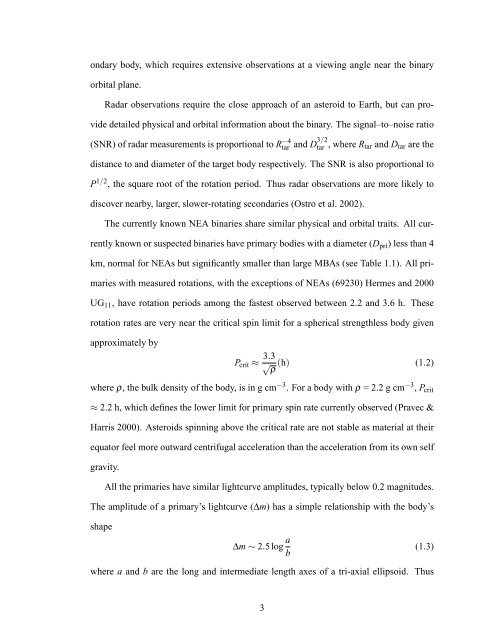Forming Binary Near-Earth Asteroids From Tidal Disruptions
Forming Binary Near-Earth Asteroids From Tidal Disruptions
Forming Binary Near-Earth Asteroids From Tidal Disruptions
You also want an ePaper? Increase the reach of your titles
YUMPU automatically turns print PDFs into web optimized ePapers that Google loves.
ondary body, which requires extensive observations at a viewing angle near the binaryorbital plane.Radar observations require the close approach of an asteroid to <strong>Earth</strong>, but can providedetailed physical and orbital information about the binary. The signal–to–noise ratio(SNR) of radar measurements is proportional to R −4tarand D3/2 tar , where R tar and D tar are thedistance to and diameter of the target body respectively. The SNR is also proportional toP 1/2 , the square root of the rotation period. Thus radar observations are more likely todiscover nearby, larger, slower-rotating secondaries (Ostro et al. 2002).The currently known NEA binaries share similar physical and orbital traits. All currentlyknown or suspected binaries have primary bodies with a diameter (D pri ) less than 4km, normal for NEAs but significantly smaller than large MBAs (see Table 1.1). All primarieswith measured rotations, with the exceptions of NEAs (69230) Hermes and 2000UG 11 , have rotation periods among the fastest observed between 2.2 and 3.6 h. Theserotation rates are very near the critical spin limit for a spherical strengthless body givenapproximately byP crit ≈ 3.3 √ ρ(h) (1.2)where ρ, the bulk density of the body, is in g cm −3 . For a body with ρ = 2.2 g cm −3 , P crit≈ 2.2 h, which defines the lower limit for primary spin rate currently observed (Pravec &Harris 2000). <strong>Asteroids</strong> spinning above the critical rate are not stable as material at theirequator feel more outward centrifugal acceleration than the acceleration from its own selfgravity.All the primaries have similar lightcurve amplitudes, typically below 0.2 magnitudes.The amplitude of a primary’s lightcurve (∆m) has a simple relationship with the body’sshape∆m ∼ 2.5log a b(1.3)where a and b are the long and intermediate length axes of a tri-axial ellipsoid. Thus3












